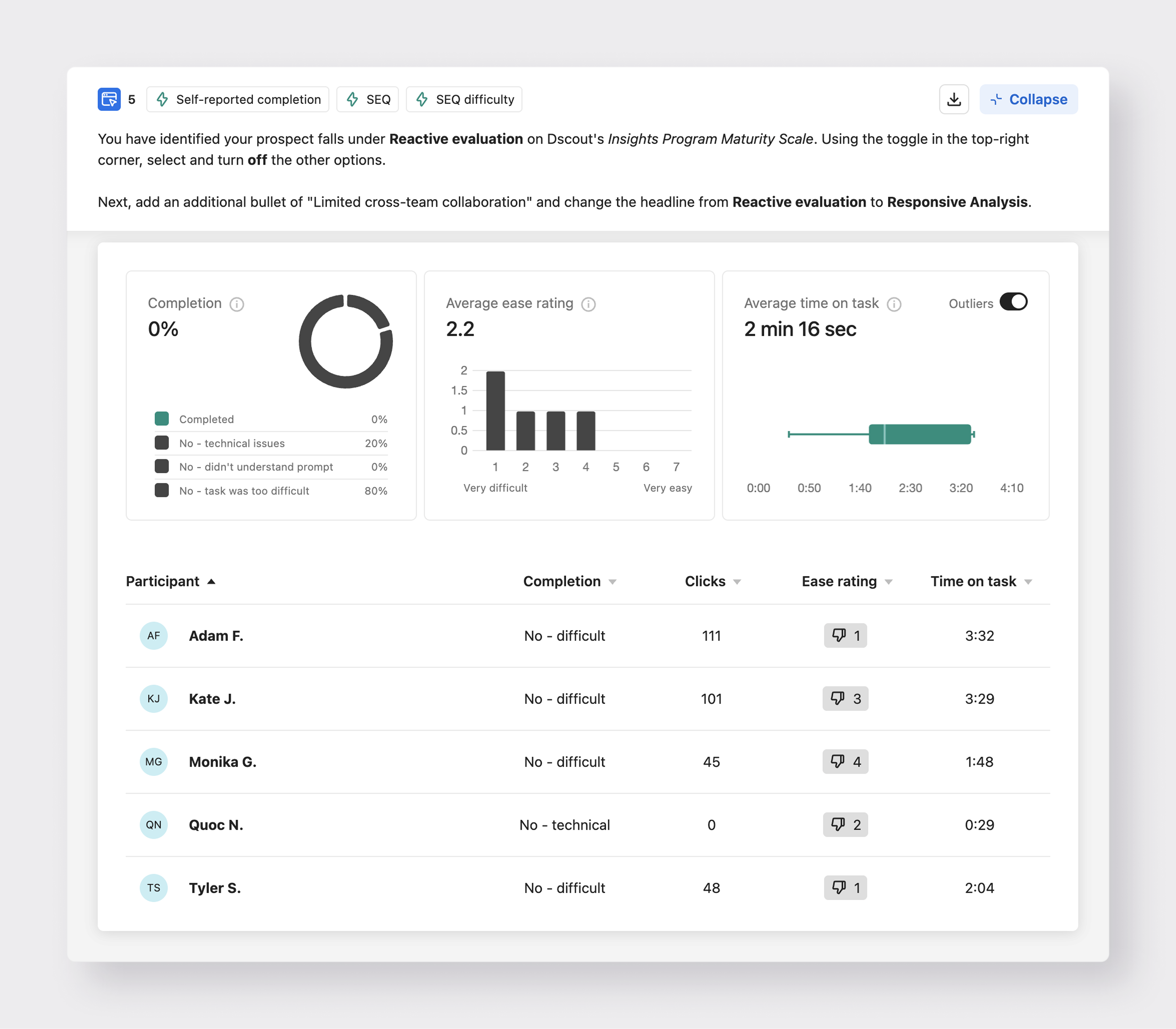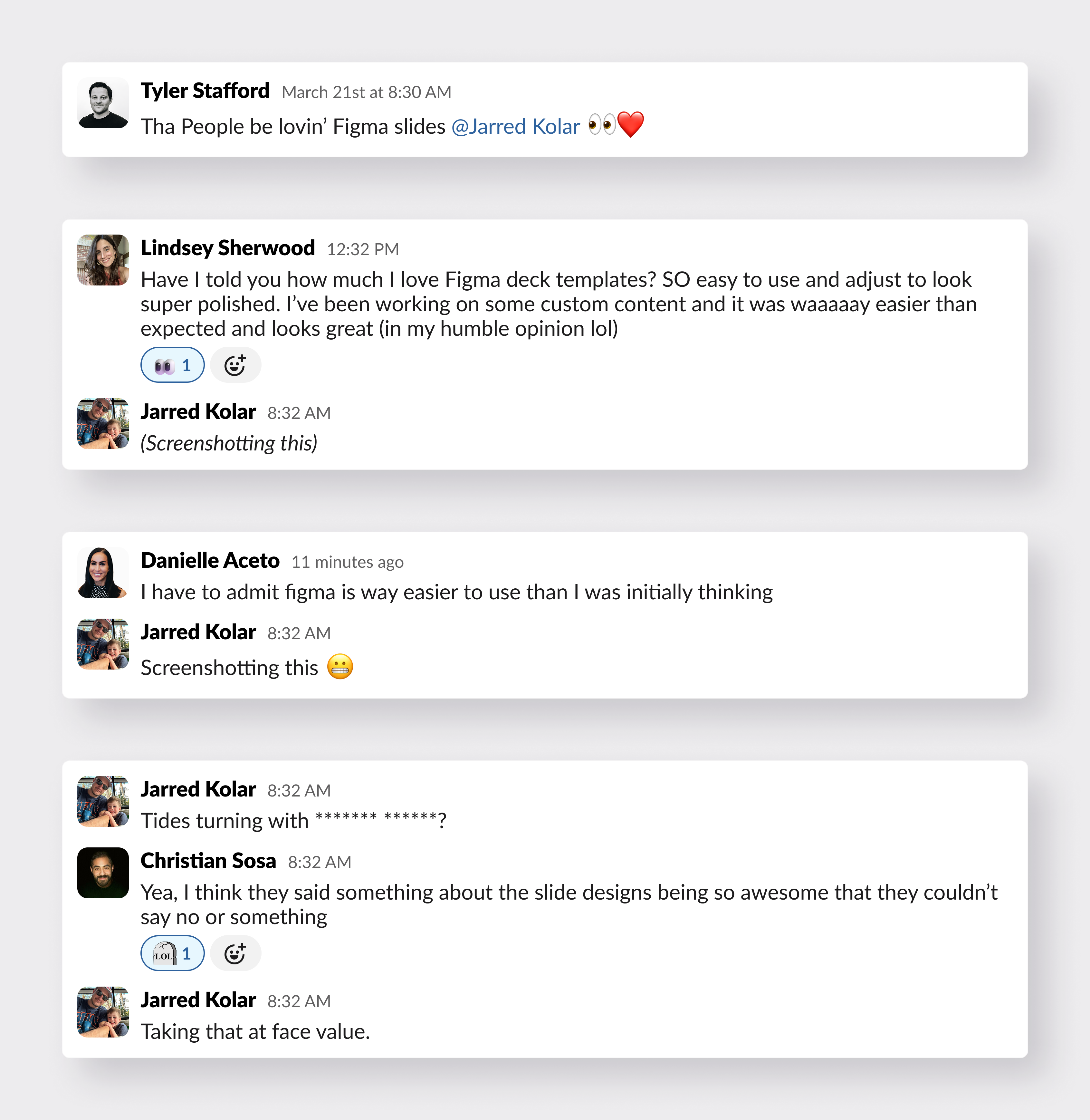Topics
October 17, 2025



October 17, 2025



Earlier this year, Dscout’s Brand Design team made a bet: ditching legacy presentation software for Figma Slides would help make our sales team more effective.
Despite heavy skepticism, the bet paid off.
For years, those legacy presentation tools were a must. They were…
But as familiar as they were, they had their limits. Features were rudimentary, innovation stagnant. Designers hit creative ceilings, brand consistency required constant monitoring, and everyone littered files across different drives.
The execution side especially caused pain for our brand designers.
Instead of pixel-precise control, we were bound by rudimentary measurements—literally working in inches (and decimals). What should have been quick design adjustments—became slow, laborious fixes, often lacking consistency from one presentation to another.
Those small inefficiencies added up, creating friction with other disciplines and an ever-growing backlog of presentation requests.
We needed something better—something more efficient, something that aligned with Dscout’s design, research, and storytelling values. Enter Figma Slides. But again, our legacy tools were tried and true. In order to implement change, we needed to prove Figma Slides’ value beyond aesthetics.
So as Dscouters, we decided to drink our own champagne and approach this potential transition not only as designers, but as researchers.
At first glance, choosing a design-first presentation platform like Figma Slides feels straightforward. It’s modern, flexible, and more aligned with design best practices.
But the reality is more complex. Tools don’t exist in isolation. They live intertwined in the messy, collaborative, day-to-day of teams trying to do good work.
Replacing tools also takes a lot more than enthusiasm. It’s a business decision that requires evidence, collaboration, and a clear picture of its impact.
As we dove into our evaluation, two groups stood out:
Without both groups aligned, even the best tools fail.
At Dscout, design is woven into everything we do. Teams across Brand Design, Product Design, Marketing, and even our CEO view design quality and brand consistency as non-negotiable.
That made the case for Figma Slides simple. It wasn’t hard to show how design-first features would help scale brand consistency, reduce duplicative effort, and save hours otherwise spent “fixing” presentations.
In Figma Slides, teams could rely on shared styles, reusable components, and templates built once, easily updated and used by everyone.
Those efficiencies quickly added up, so getting buy-in from design teams was the easy part. What came next would require more convincing.
The real test was convincing the teams who build and present every day—our Sales and Customer Success organizations.
They both move fast and often under tight deadlines. For them, efficiency isn’t optional—it’s the difference between momentum and missed opportunity. On these teams, design quality was often sacrificed for speed, and working with a new tool could cost precious time before a client meeting.
From their perspective, sticking with the familiar often feels safer than adopting something new, even if that new tool promises better outcomes and faster execution.
So the question became: How do we ensure this transition works not just for design and marketing, but for the teams whose day-to-day (and commission) depend on it?
It wasn’t enough to prove the tool could make our presentations “look better”. We had to show it could handle the pace and unpredictability of day-to-day sales challenges without slowing anyone down.
At Dscout, our mission is to help organizations better understand their users. Applying that principle internally was the clear next step.
We started with research:
Our first usability test was, in many ways, a failure. (*GASPS*)

As someone still learning the nuances of quality research, I leaned too heavily into those robust features that excited the designer in me—type styles, auto-layouts, and component variants.
While I believed these could be game-changers for me and my team, introducing them too early made Figma Slides feel too complex and didn’t address the Sales and Customer Success team’s underlying, main concern: how their current workflows would translate.
“That misstep was humbling, but valuable. It reminded us (and me) that research isn’t about perfection. It doesn’t have to be scary or intimidating. It’s simply about learning. A “bad” test can still reveal great insights, as long as you’re listening.”
Jarred Kolar, Senior Brand Director at Dscout
Dscout’s “Talk out loud” prompts allowed Sales and CS to articulate their real frustrations and fears:
This feedback reframed the conversation. It revealed that many of the challenges Sales worried about were solvable with Figma Slides and, in some cases, actually easier.
The following features all helped make building presentations faster and more autonomous than ever:
We also created a library of quick, self-serve tutorials that Sales and CS reps could tap into anytime to learn new features, build confidence, and keep work moving.
“This was a real moment of clarity for the Brand Design team: research doesn’t have to be a scary, heavy lift. It doesn’t always have to be reviewed by “experts”. It can be lightweight, fast, and approachable.”
Jarred Kolar, Senior Brand Director at Dscout
Even with a shaky start, we uncovered the insights we needed to push forward and ultimately implement Figma Slides company-wide.
Several lessons stood out—ones that apply to any team considering a major tool shift:

The lesson is simple: tool adoption isn’t about the tool. It’s about people, process, and alignment.
At Dscout, we wouldn’t ask customers to make a research decision without evidence, empathy, and iteration. The same should be true for the tools we use internally.
And importantly, research doesn’t need to feel scary or inaccessible. You don’t need to run a massive study or write a 50-page report. Sometimes it’s just about asking people to try something, listening closely, and adjusting based on what you hear.
For us, the switch to Figma Slides wasn’t just about making the Brand Design team’s day-to-day easier. It was a chance to practice what we preach, learn alongside our colleagues, and show that research can be simple, approachable, and empowering for everyone.
We’ve seen a significant cultural shift since adopting Figma Slides over the past few months.

Our biggest skeptics are now Figma Slides champions. Presentations feel more cohesive. Collaboration feels smoother, and our prospects and customers have taken note of our work.
Most importantly, teams that once resisted are now suggesting new ways to make Figma Slides even more valuable.
In other words, adoption has become less about convincing people to use Figma Slides and more about exploring how we can all get better at using it together.